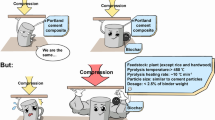Abstract
A model for predicting time-dependent chloride binding capacity of cement-fly ash cementitious systems was proposed. The proposed model took into account both chemical binding and physical binding. Chemical binding was considered to depend on the amount of unhydrated aluminated and aluminoferrite phases while physical binding depended upon the quantity of hydrated and pozzolanic products. The concept of time-dependent chloride binding capacity was introduced in the model with the consideration of curing time and chloride exposure period. The chloride binding of cement pastes and cement-fly ash pastes under different curing times and chloride exposure periods were tested. Three types of cement and two types of fly ash were used. From the experimental results, time-dependent behavior of chloride binding capacity was observed. At the same chloride exposure period, pastes with longer curing time prior to chloride exposure bound less chloride than those exposed with shorter curing time. Longer exposure period of paste resulted in larger chloride binding capacity. The analytical results from the model were verified with the experimental results from the authors and other researchers. The verification showed that the proposed model was satisfactory for predicting the chloride binding capacity of various cement and cement-fly ash cementitious systems.
Résumé
L'article présente un modèle capable de prévoir la capacité d'un mélange ciment-cendres volantes de fixer les ions chlorures. Il prend en compte à la fois les liaisons chimiques et les liaisons physiques. Les liaisons chimiques dépendent de la quantité d'aluminate non hydraté ainsi que de la quantité d'alumino-ferrite alors que les liaisons physiques dépendent de la quantité de produits hydratés et de la quantité de pouzzolane. La variable temporelle a été introduite afin de prendre en compte la durée de cure ainsi que la durée d'exposition aux chlorures. Trois types de ciment et deux types de cendres volantes ont été utilisés et plusieurs durées de cure et d'exposition aux chlorures ont été testées. Pour la même durée d'exposition au chlorure, les pâtes ayant un temps de cuisson plus long avant d'être exposées au chlorure ont une capacité de liaison du chlorure moindre que celles exposées avec des temps de cuisson plus court. Un autre résultat est que la capacité de fixer les ions chlorures augmente avec la durée d'exposition aux ions chlorures. Les résultats analytiques du model ont été confrontés aux résultats expérimentaux des auteurs de l'article ainsi qu'aux résultats publiés dans la littérature. Cette vérification a montré que les prédictions du model analytique sont conformes aux résultats de l'expérience.
Similar content being viewed by others
References
Arya, C., Buenfeld, N.R. and Newman, J.B., ‘Factors influencing chloride-binding in concrete’,Cem. Con. Res. 20 (2) (1990) 291–300.
Ramachadran, S., Seeley, R.C. and Polomark, G.M., ‘Free and combined chloride in hydrating cement and cement compounds’,Mater. Struct. 17 (1984) 285–289.
Theissing, E.M., Mebius-Van De Laar, T. and De Wind, G., ‘The combining of sodium chloride and calcium chloride by the hardened Portland cement compounds C3S, C2S, C3A and C4AF’, Proceedings of 8th International Symposium on Chemistry of Cement, Rio de Janeiro, 1986, 823–828.
Rasheeduzzafar, Hussain, E.S. and Al-Saadoun, S.S., ‘Effect of cement composition on chloride binding and corrosion of reinforcing steel in concrete’,Cem. Con. Res. 21 (5) (1991) 777–794.
Suryavanshi, A.K., Scantlebury, J.D. and Lyon, S.B., ‘The binding of chloride ions by sulphate resistant Portland cement’,Cem. Con. Res. 25 (3) (1995) 581–592.
Csizmadia, J., Balazs, G. and Tamas, F.D., ‘Chloride ion binding capacity of aluminoferrites’,Cem. Con. Res. 31 (4) (2001) 577–588.
Dhir, R.K., El-Mohr, M.A.K. and Dyer, T.D., ‘Chloride Binding in GGBS concrete’,Cem. Con. Res. 26 (12) (1996) 1767–1773.
Hussain, E.S., Rasheeduzzafar and Al-Gahtani, A.S., ‘Influence of sulfates on chloride binding in cements’,Cem. Con. Res. 24 (1) (1994) 8–24.
Xu Y., ‘The influence of sulphates on chloride binding and pore solution chemistry’,Cem. Con. Res. 27 (12) (1997) 1841–1850.
Jensen, O.M., Korzen, M.S.H., Jakobsen, H.J. and Skibsted, J., ‘Influence of cement constitution and temperature on chloride binding in cement paste’,Advances in Cement Research 12 (2000) 57–64.
Luping, T. and Nilsson, L.-O., ‘Chloride binding capacity and binding isotherms of OPC pastes and mortars’,Cem. Con. Res. 23 (2) (1993) 247–253.
Delagrave, A., Marchand, J., Ollivier, J.P., Julien, S. and Hazrati K., ‘Chloride binding capacity of various hydrated cement paste systems’,Advanced Cement Based Materials 6 (1) (1997) 28–35.
Jensen, H.-U. and Pratt, P.L., ‘The binding of chloride ions by pozzolanic product in fly ash cement blends’,Advances in Cement Research 2 (7) (1989) 121–129.
Nipatsat, N. and Tangtermsirikul, S., ‘Compressive strength prediction model for fly ash concrete’,Thammasat International Journal of Science and Technology 11 (2000) 1–7.
Tangtermsirikul, S. and Saengsoy, W., ‘Simulation of free water content of paste with fly ash’,Research and Development Journal of the Engineering Institute of Thailand 13 (2002) 1–10.
Damidot, D. and Glasser, F.P., ‘Thermodynamic investigation of the CaO−Al2O3−CaSO4−CaCl2−H2O system and the influence of Na2O’, 10th Congress on the Chemistry of Cement, Gothenburg, Sweden, 1997.
Mindess, S. and Young, J.F., ‘Concrete’, (Prentice-Hall, New Jersey, 1981).
Maruya T., Tangtermsirikul, S. and Matsuoka Y., ‘Modeling of chloride movement in the surface layer of hardened concrete”,Concrete Library International of JSCE 32 (1998) 69–84.
Author information
Authors and Affiliations
Rights and permissions
About this article
Cite this article
Sumranwanich, T., Tangtermsirikul, S. A model for predicting time-dependent chloride binding capacity of cement-fly ash cementitious system. Mat. Struct. 37, 387–396 (2004). https://doi.org/10.1007/BF02479635
Received:
Accepted:
Issue Date:
DOI: https://doi.org/10.1007/BF02479635




